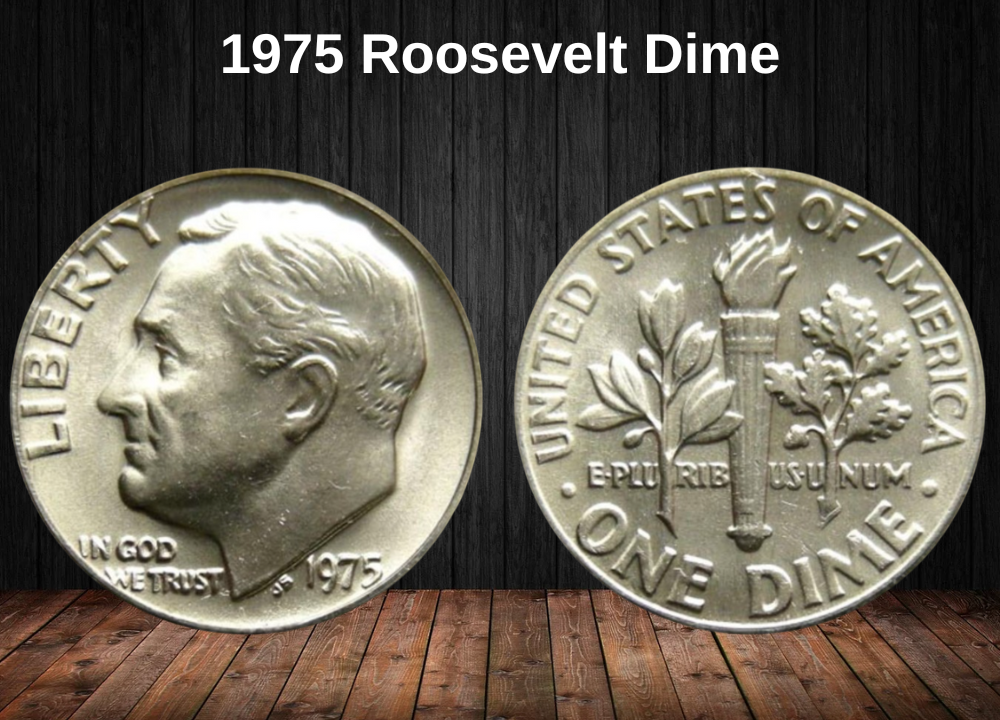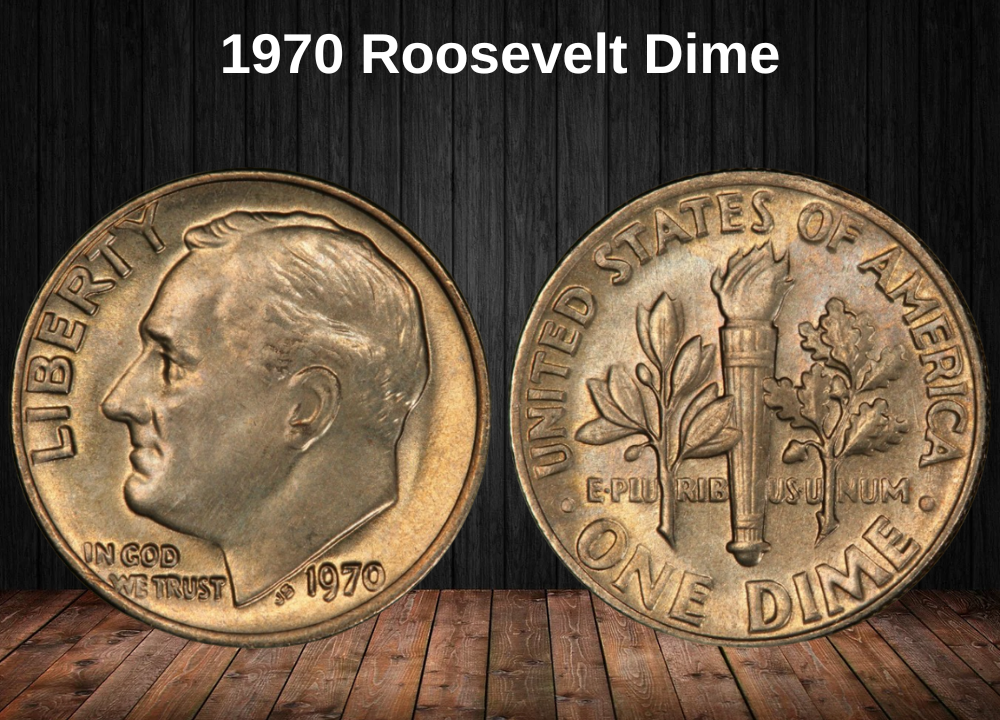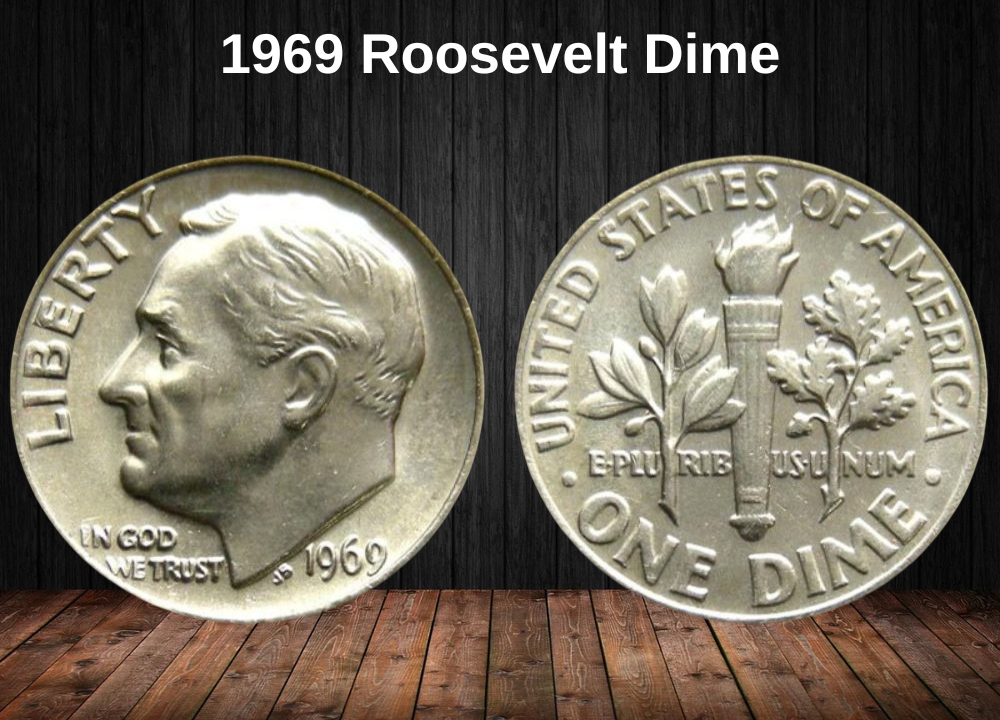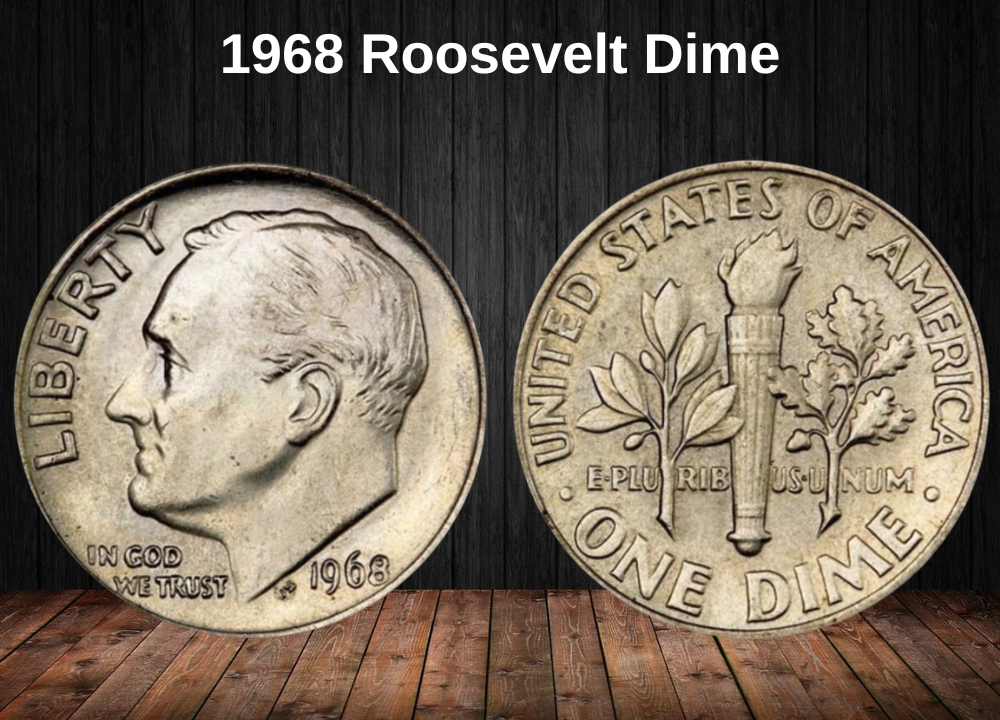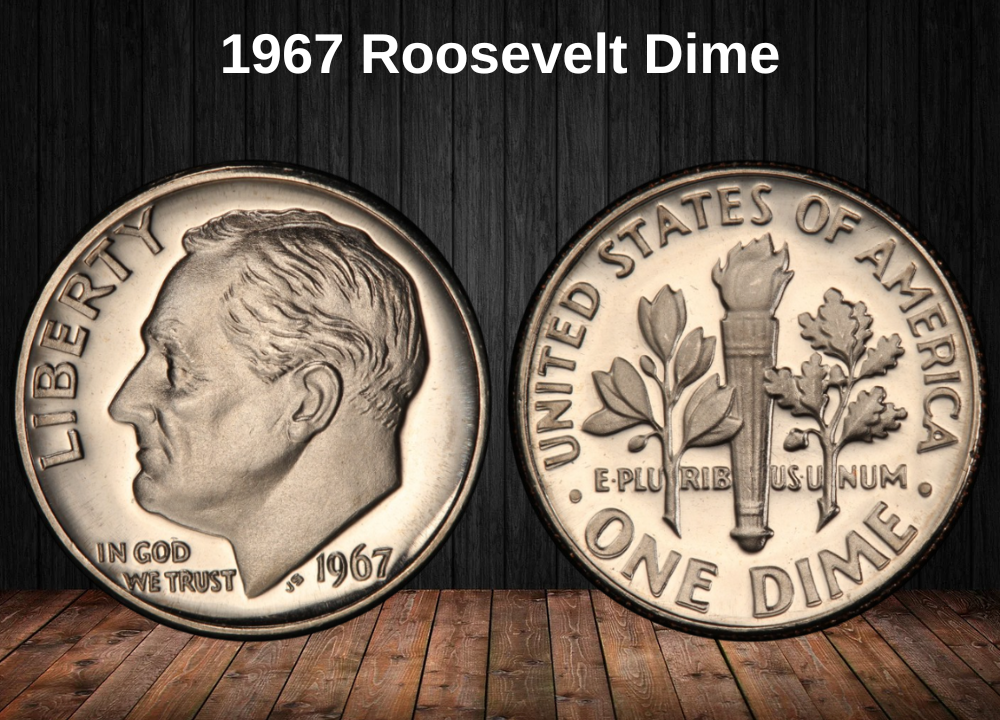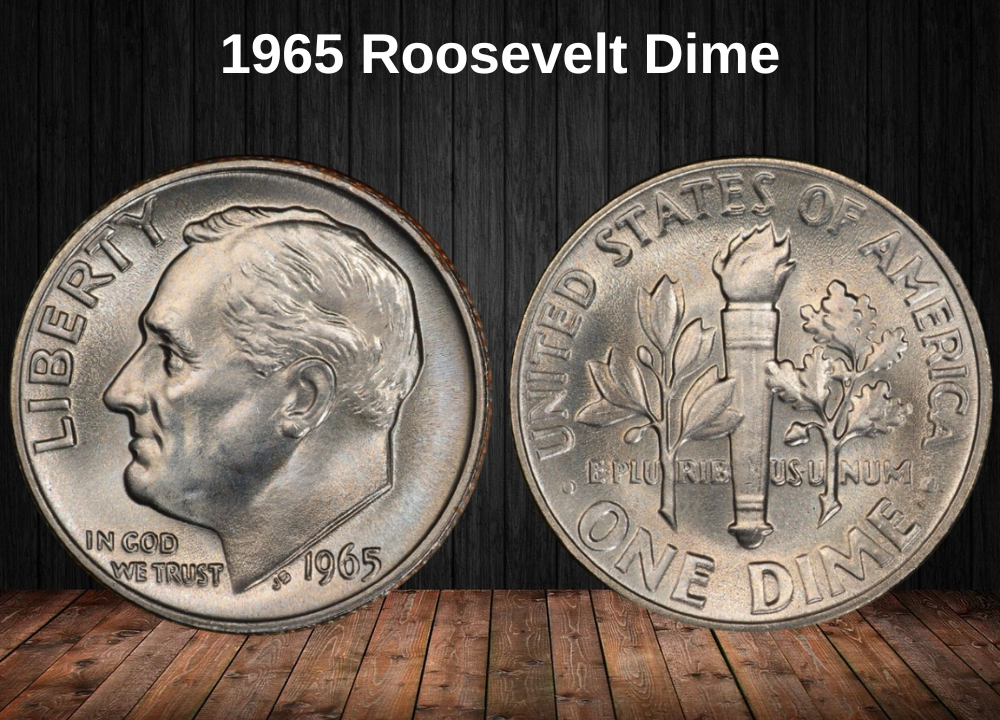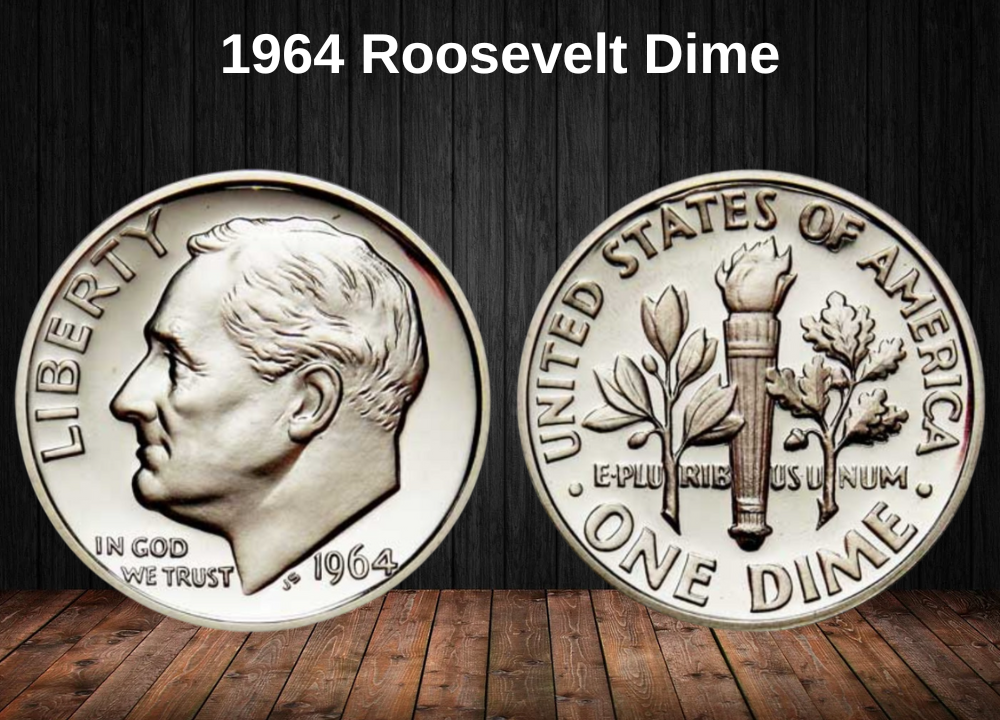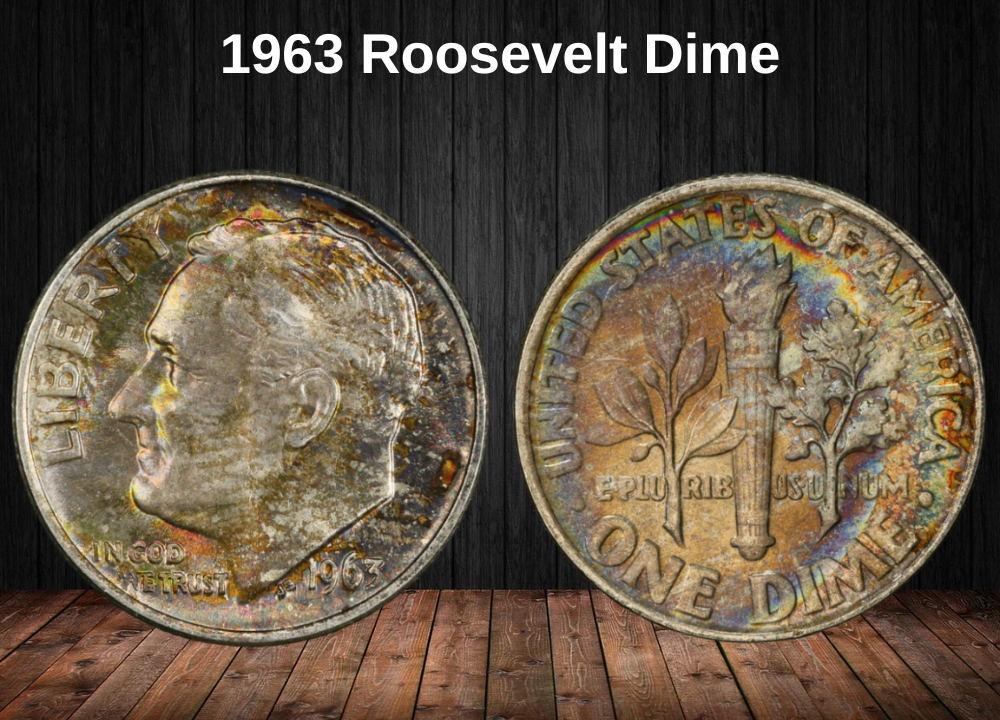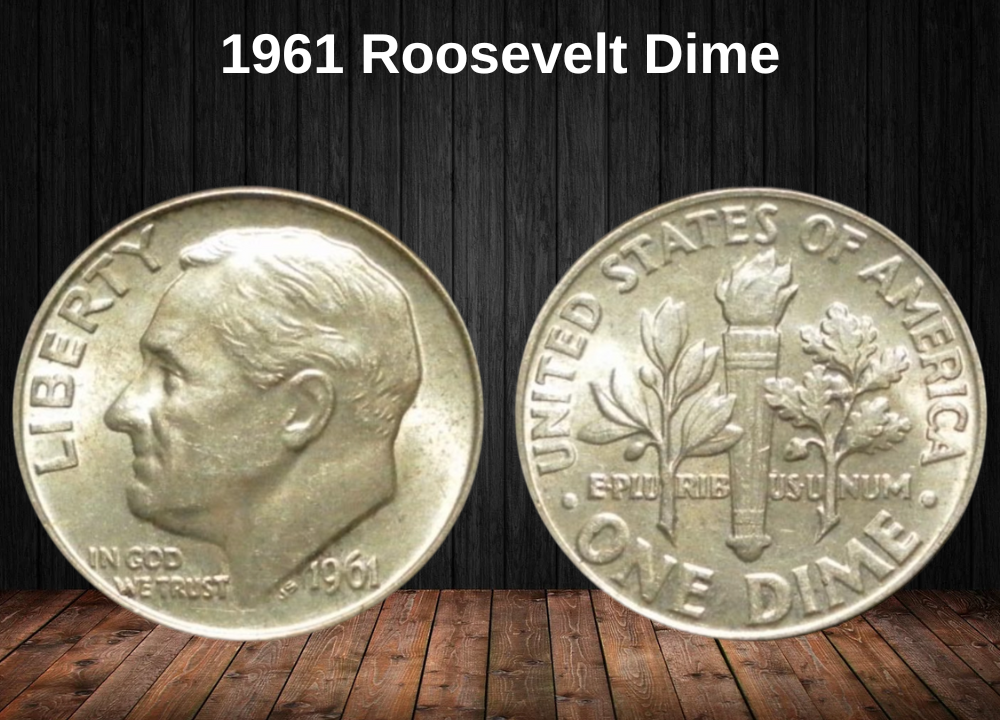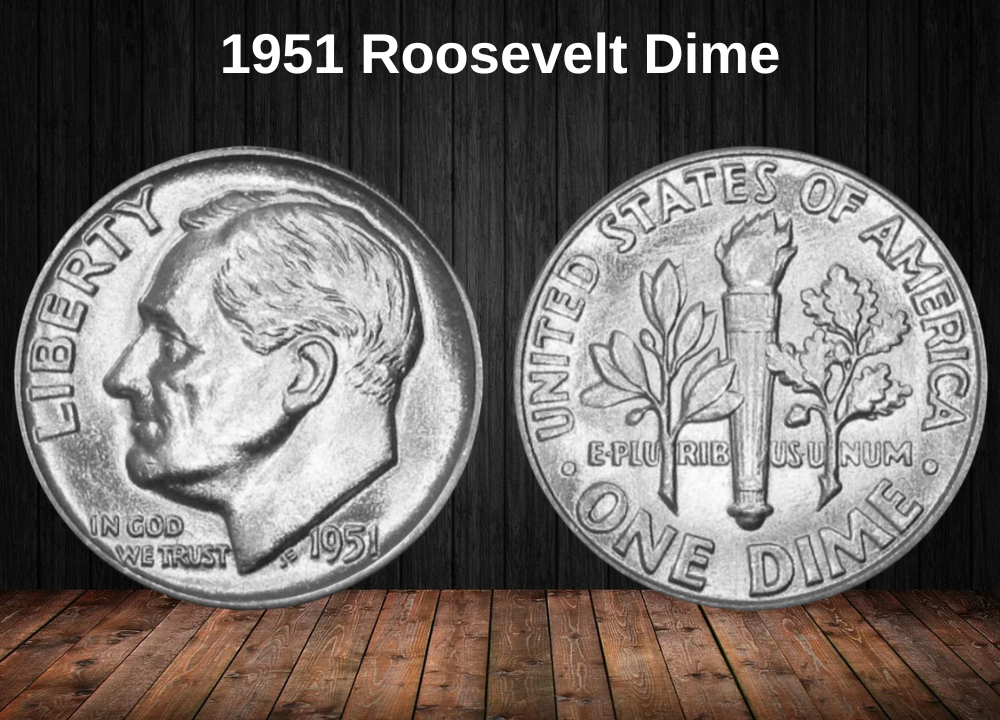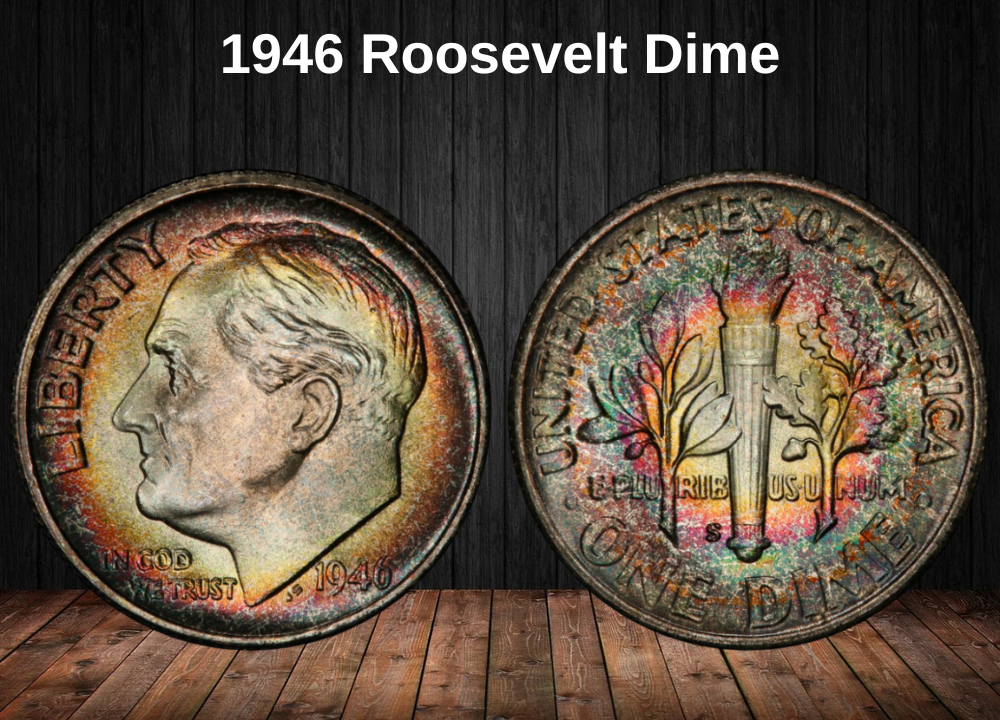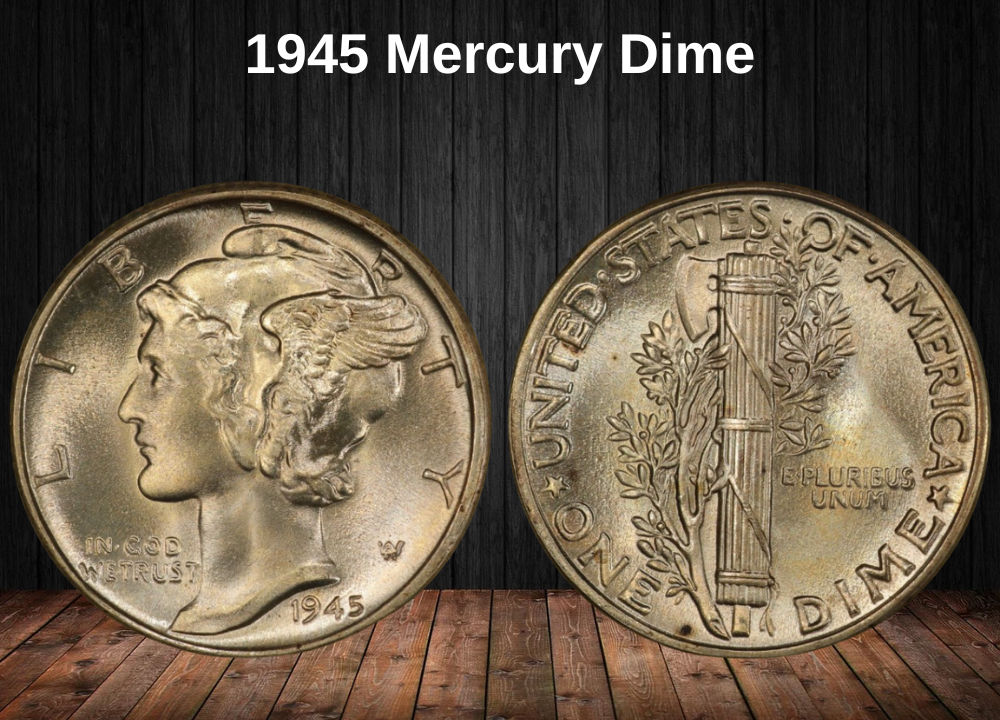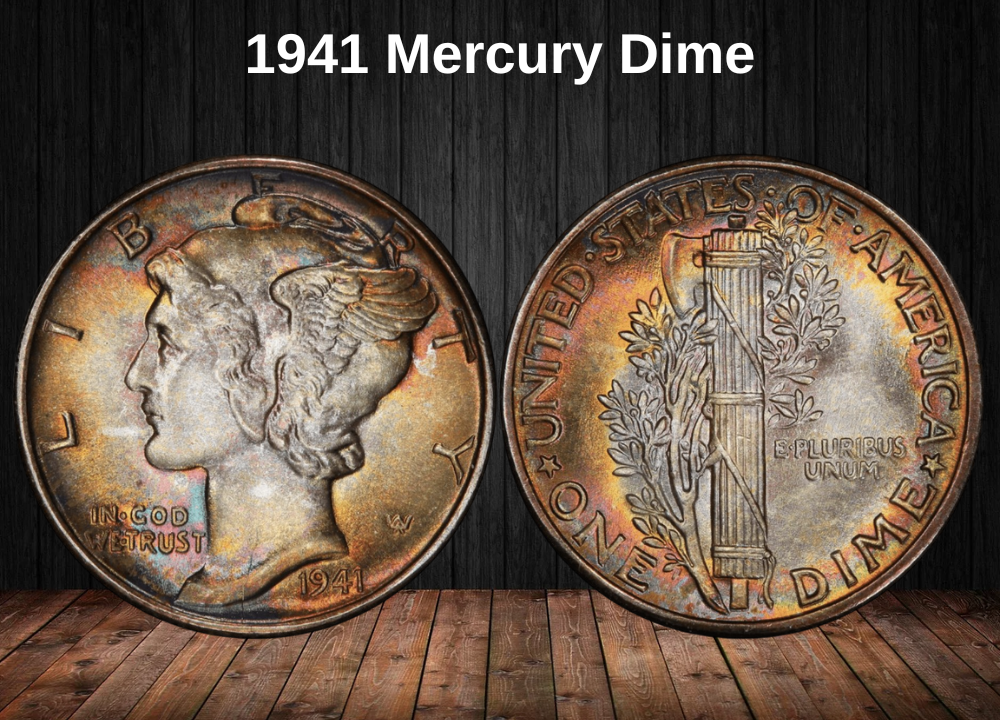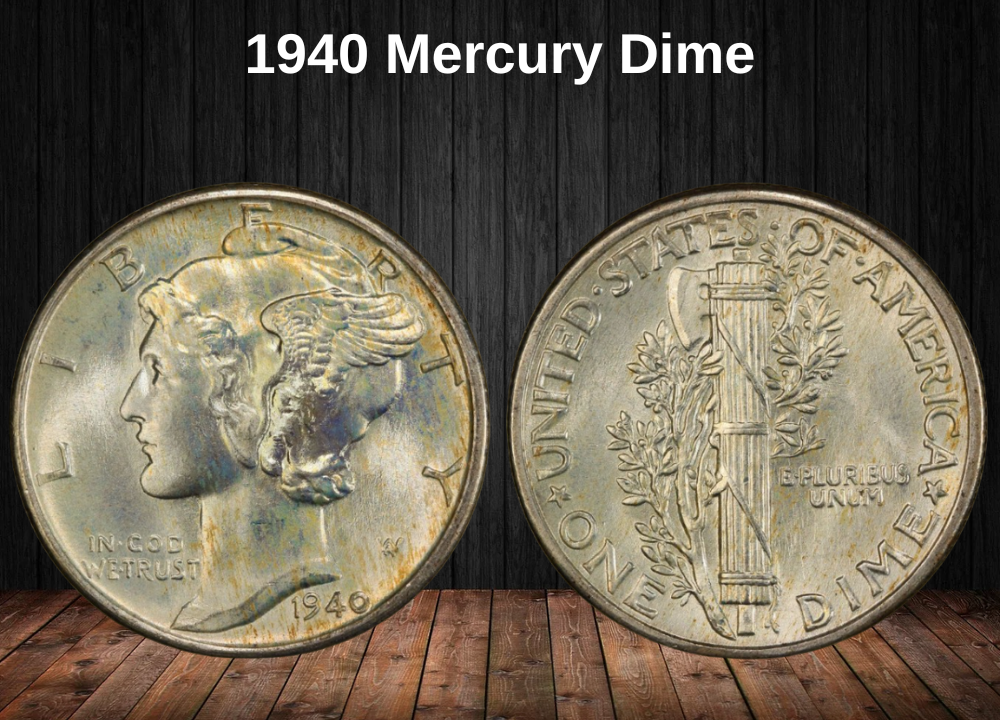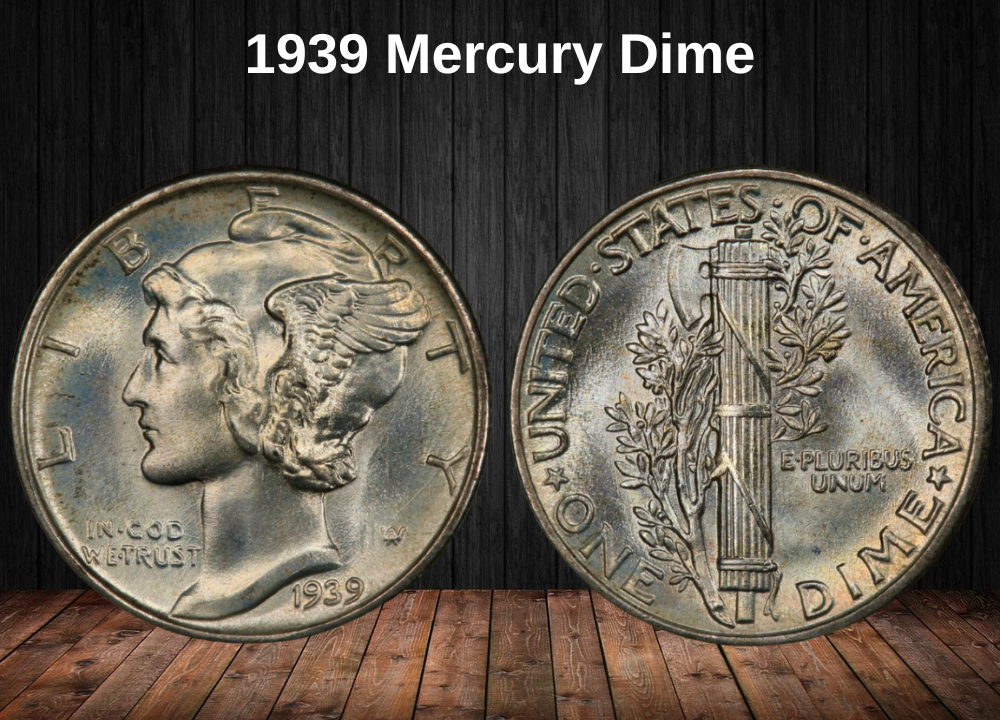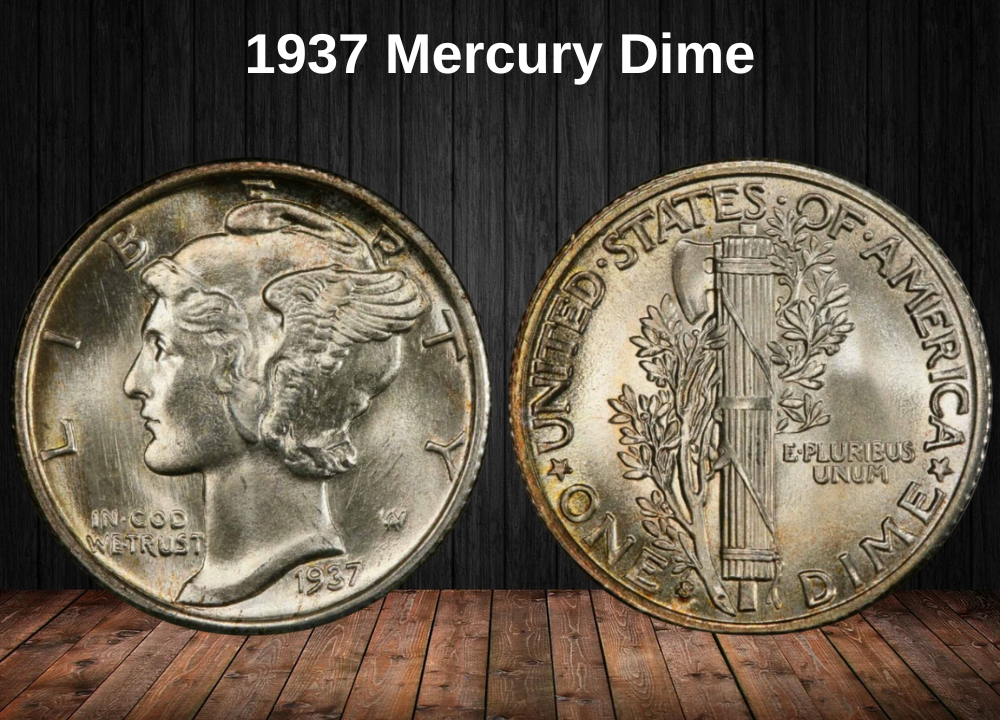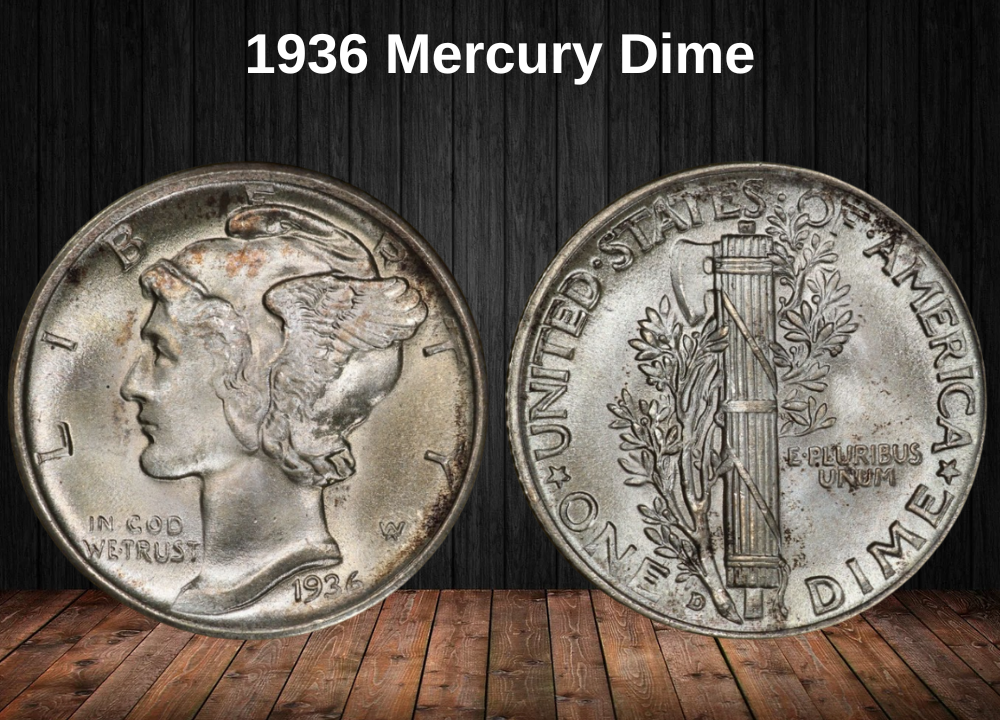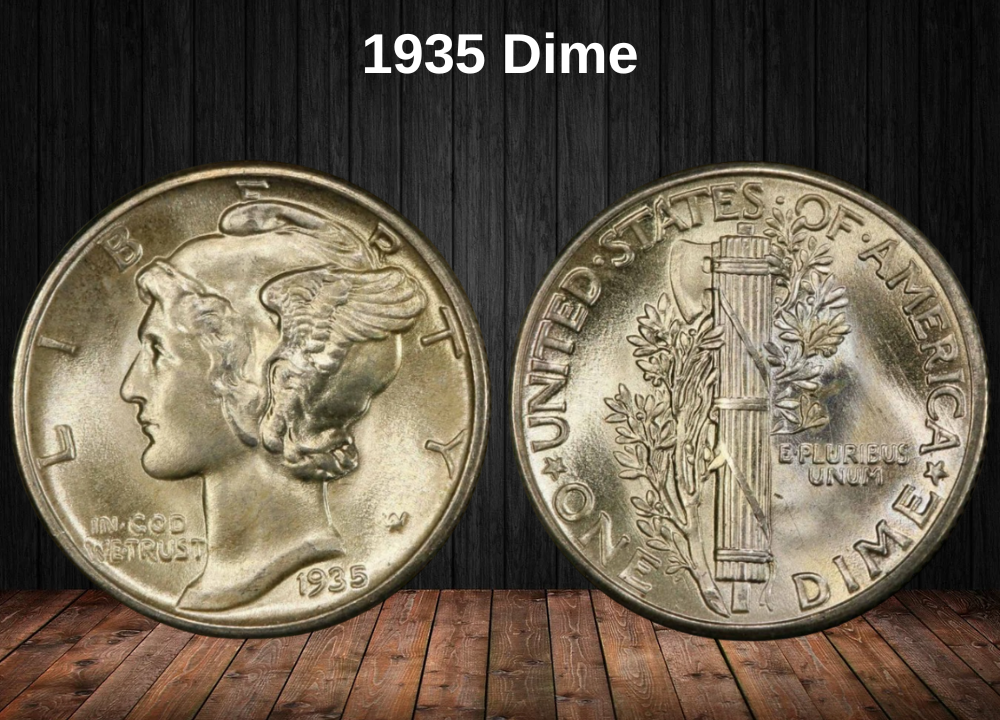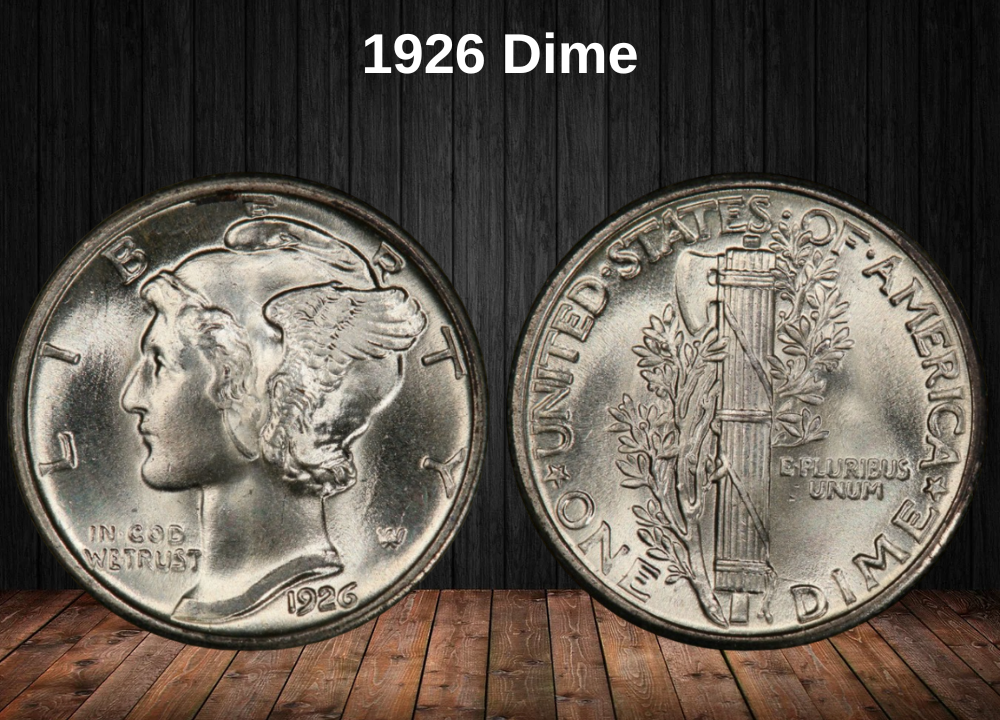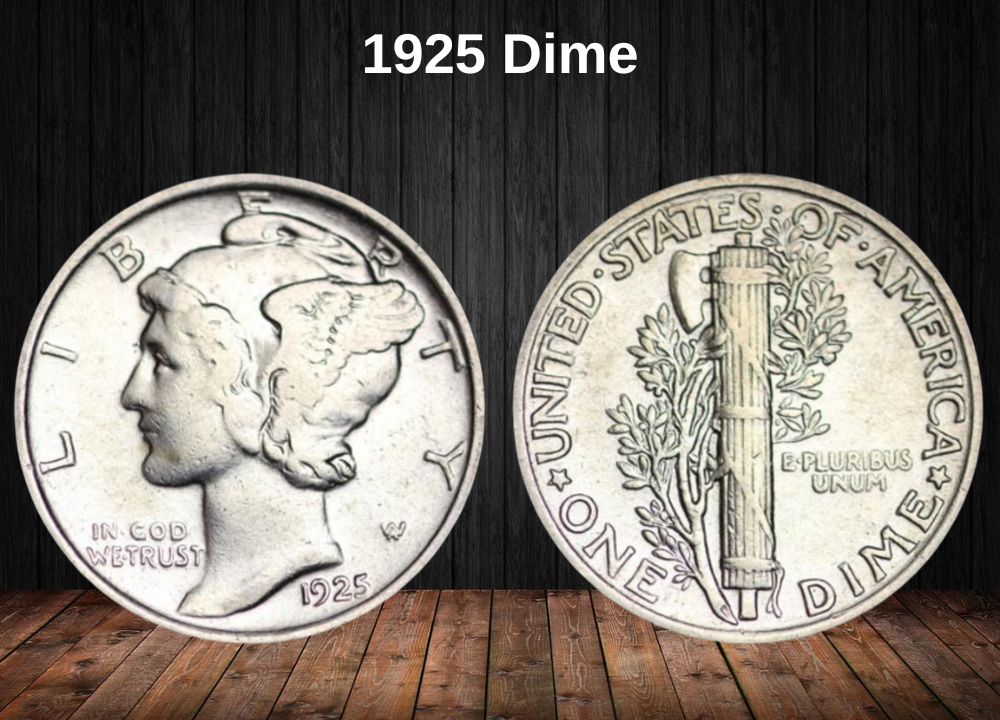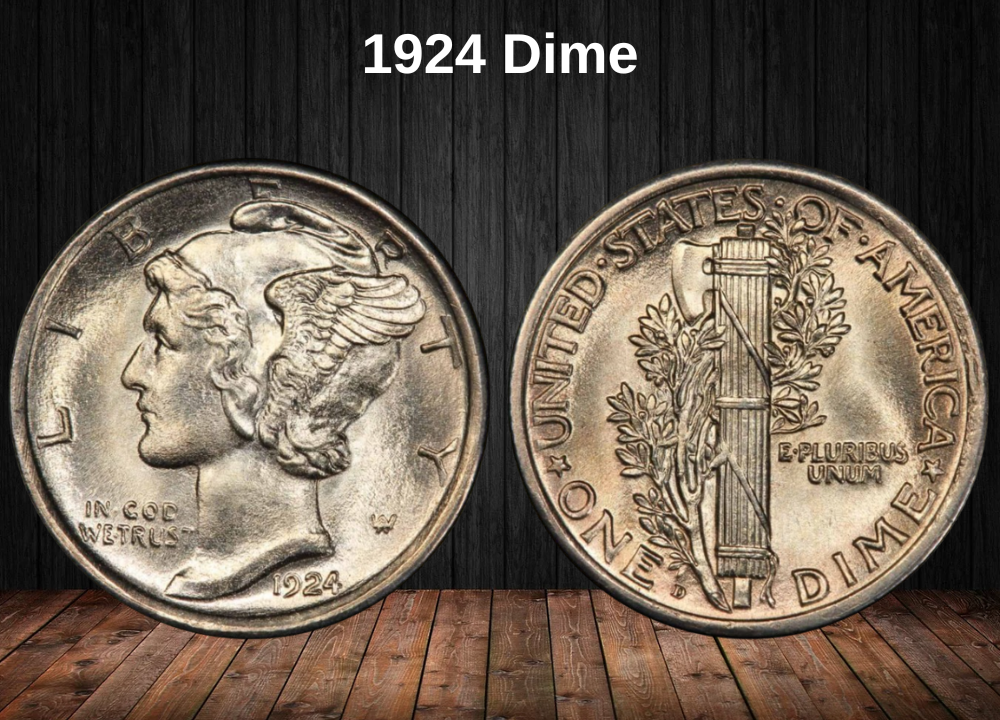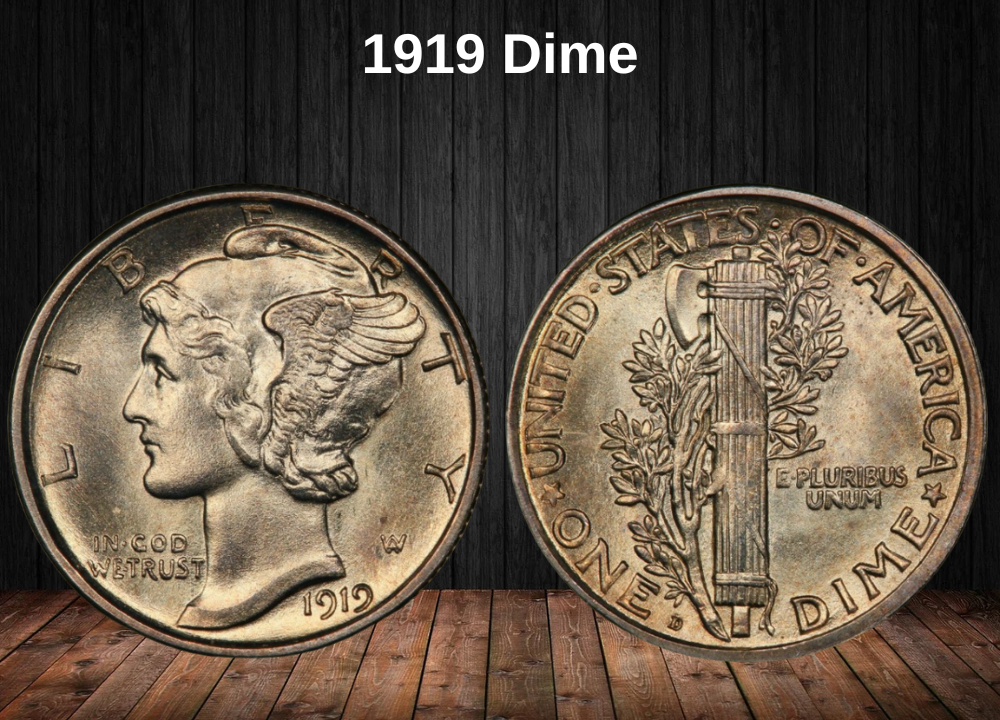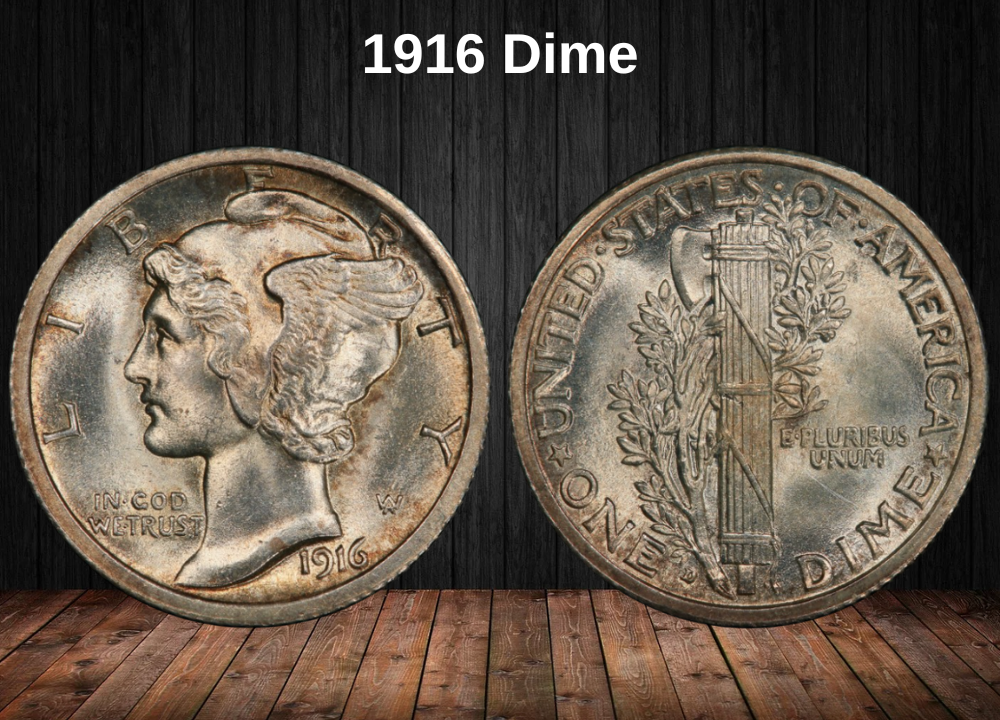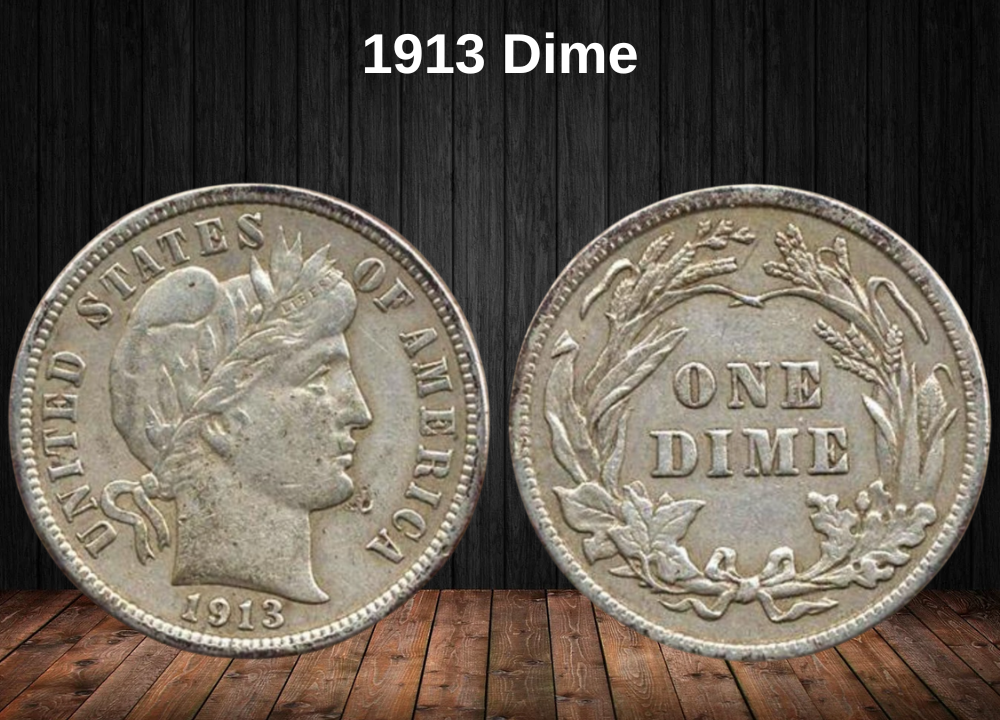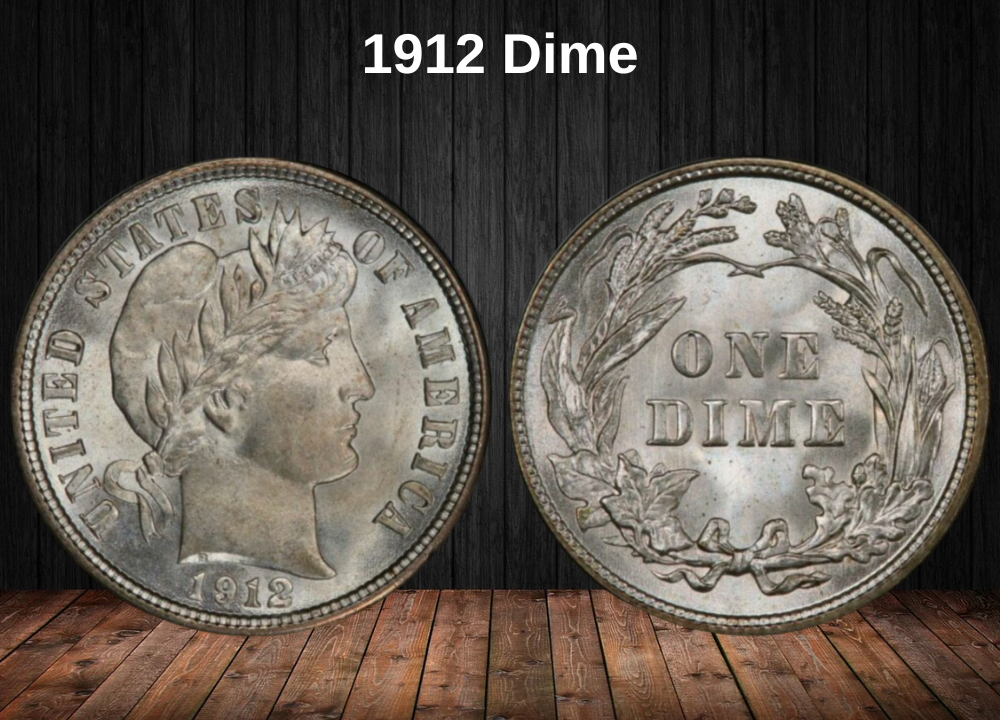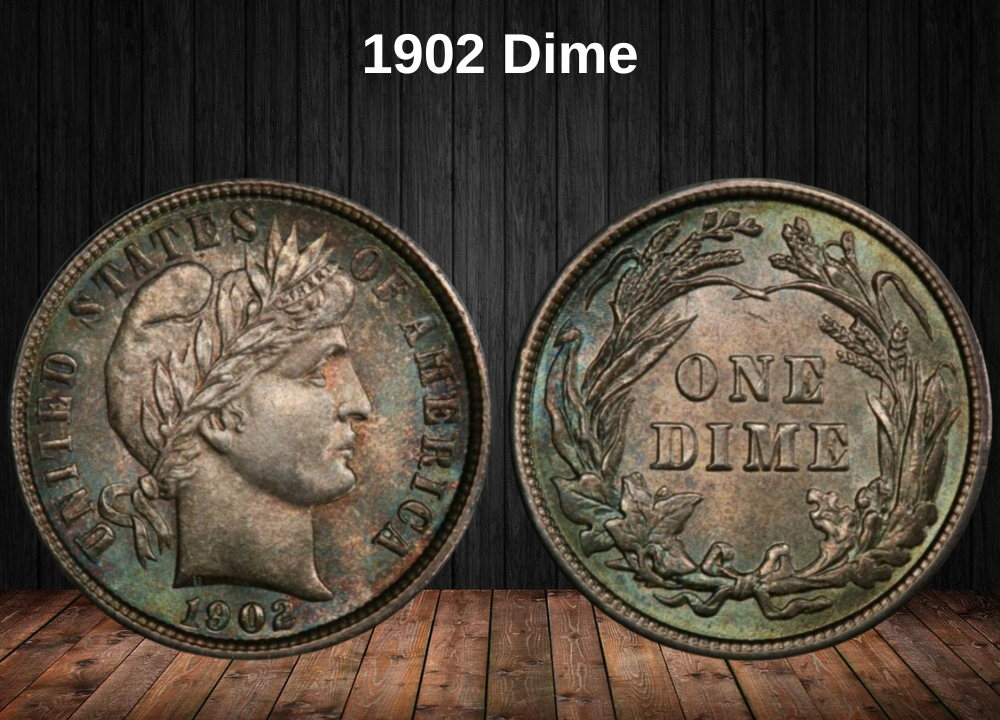From 1942 to 1945, many U.S. coins saw composition changes to support the World War II effort, as copper and nickel were redirected to military production. Pennies were made of steel and zinc, nickels had silver, but the dime kept its traditional 90% silver, 10% copper alloy. That means 1944 Mercury dimes remain popular not only for their history, but also for their silver content and collectible value.
1944 Mercury Dime Value Chart
| Coin | MS 60 FB | MS 63 FB | MS 65 FB | MS 66+ FB | MS 67+ FB | MS 68 FB |
|---|---|---|---|---|---|---|
| 1944 (P) No Mint Mark Dime | $15 | $34 | $95 | $500 | $1,650 | $12,500 |
| 1944-D Dime | $15 | $34 | $68 | $135 | $385 | $1,000 |
| 1944-S Dime | $20 | $35 | $90 | $165 | $1,050 | $4,250 |
(FB = Full Bands designation, meaning sharper detail on the reverse fasces bands, increasing collector value.)
History of the 1944 Mercury Dime
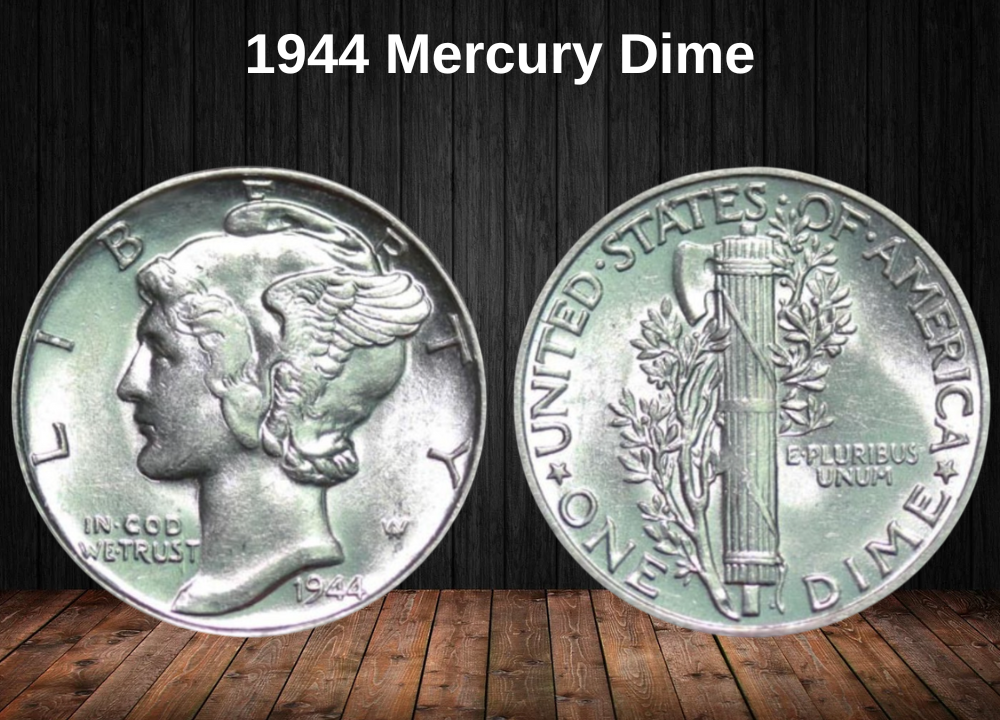
The dime has been America’s 10-cent coin since 1792. Because of its silver content, the coin was deliberately made small—if it were larger, the melt value of silver might exceed its face value, encouraging people to melt them down for profit. This actually happened to many silver coins when silver prices spiked in later decades.
In 1944, the circulating dime was the Mercury dime, officially named the Winged Liberty Head dime. The nickname “Mercury” came from the obverse design, where Liberty wears a winged Phrygian cap. To many, it resembled the Roman god Mercury’s winged helmet, and the nickname stuck.
The portrait of Liberty was modeled on Elsie Stevens, the wife of poet and lawyer Wallace Stevens. The couple lived in an apartment above sculptor Adolph A. Weinman, the coin’s designer. Weinman later explained that Mrs. Stevens posed wearing a stocking over her head to replicate the cap.
Adolph Weinman and His Design
Adolph A. Weinman, a student of famed sculptor Augustus Saint-Gaudens, designed the Mercury dime after winning a Mint competition to replace Charles Barber’s dime design. Weinman also created the half dollar of the same era.
The Mint initially had concerns about the Mercury dime’s intricate details and high relief, since they wore down the dies faster and required stronger strikes. But despite production challenges, the coin was widely loved by the public and is still considered one of the most beautiful U.S. coins ever made.
The End of the Mercury Dime
The series lasted from 1916 to 1945. When President Franklin D. Roosevelt died in April 1945, the Treasury fast-tracked a new design to honor him. The Roosevelt dime replaced the Mercury dime in 1946 without requiring an act of Congress, since the series had already reached its 25-year minimum run.
This made the 1944 Mercury dime one of the final issues of the beloved design. As the second-to-last year of the series, it carries historical importance and attracts collector interest far beyond its silver content.
Features of the 1944 Mercury Dime
When describing a coin, the obverse refers to the “heads” side, while the reverse is the “tails” side. The edge is the thin side of the coin, often with small ridges called reeds. The raised border around the design is the rim or collar. Any figures or portraits are known as devices, the flat background is the field, and the inscriptions are called legends or mottos.
The Obverse of the 1944 Dime

The obverse shows a youthful Lady Liberty facing left. She wears a winged Phrygian cap, with strands of hair visible near her forehead. The word LIBERTY curves along the upper rim from chin to neck, with the “ER” partially covered by the cap. The motto IN GOD WE TRUST appears in front of her neck, while the designer’s initials AW (for Adolph Weinman) are inscribed behind her. The date “1944” sits just below her neckline cut-off.
The Reverse of the 1944 Dime

The reverse features a fasces—a bundle of sticks tied with leather straps, symbolizing unity and strength—topped with a small battle axe. An olive branch curves gracefully around the fasces, representing peace. At the mid-right side, the motto E PLURIBUS UNUM is inscribed, while the mint mark (D for Denver, S for San Francisco, or none for Philadelphia) appears on the lower left, near the olive branch. The top legend reads UNITED STATES OF AMERICA, and the denomination ONE DIME is positioned at the bottom.
Other Physical Features
- Composition: 90% silver, 10% copper
- Weight: 2.5 grams
- Diameter: 17.91 mm (0.705 inches)
- Edge: Reeded, with 118 reeds in total
Weinman’s design portrayed Liberty in a more youthful style than earlier U.S. coinage. He explained that the wings on her cap symbolized freedom of thought, although some art historians believe he was influenced by Saint-Gaudens, who frequently used feathered motifs in his own work.
1944 Mercury Dime Grading
| # | Grade |
|---|---|
| 1 | Basal State-1 |
| 2 | Fair |
| 3 | Very Fair |
| 4, 5, 6 | Good |
| 7, 8, 10 | Very Good |
| 12, 15 | Fine |
| 20, 30 | Very Fine |
| 40 | Extremely Fine |
| 50 | About Uncirculated |
| 60 | Mint State |
| 65 | Mint State |
| 70 | Mint State |
1944 Mercury Dime Value Guides
Because the 1944 Mercury Dime is struck in fine silver, its melt value is tied to the current market price of the metal. Even in the lowest circulated grades, its silver content gives it a baseline value of a few dollars. However, the real premiums come from minting location, grade, strike quality (especially Full Bands), and rarity. Below is a breakdown of values by mintmark.
1944 No Mint Mark Dime Value (Philadelphia)
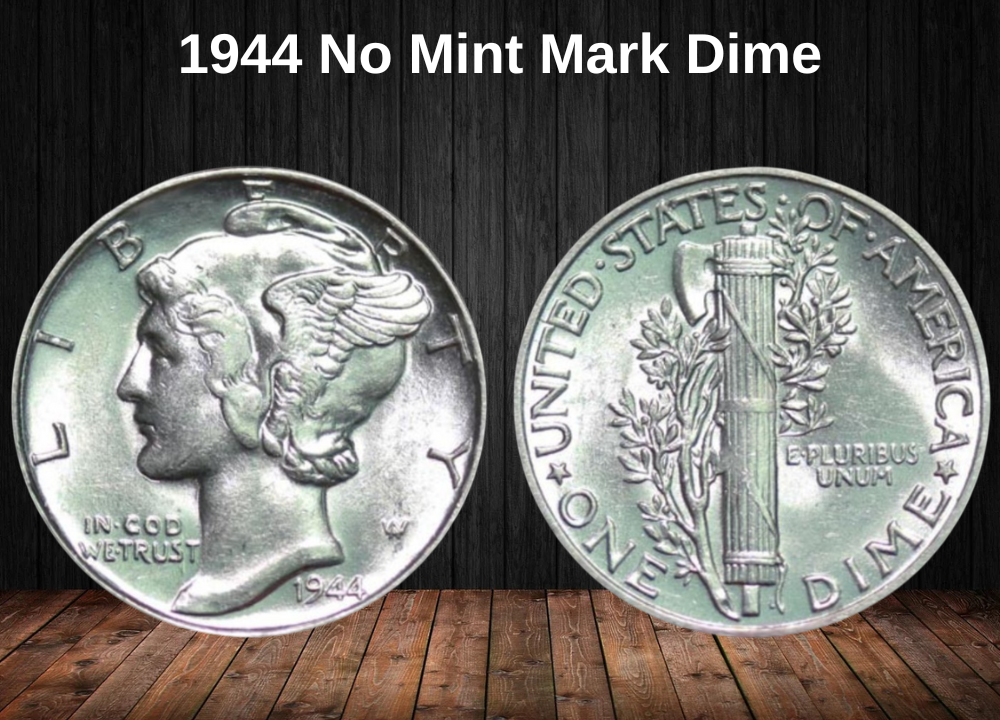
The Philadelphia Mint struck 231,410,000 dimes in 1944, none carrying a mint mark. These are the most common of the year, yet high-grade survivors are very desirable.
- In December 2016, one graded MS67+ sold for $1,410.
- A spectacular MS68 FB (Full Bands) realized $25,300 on January 1, 2009—a record-setting “Happy New Year” sale!
- Only 9 coins are known in MS68 FB. By 2025, this top grade example is estimated around $12,500.
Takeaway: Average Mint State examples are common, but anything MS67 and higher with Full Bands is a collector’s prize.
1944-D Dime Value (Denver)
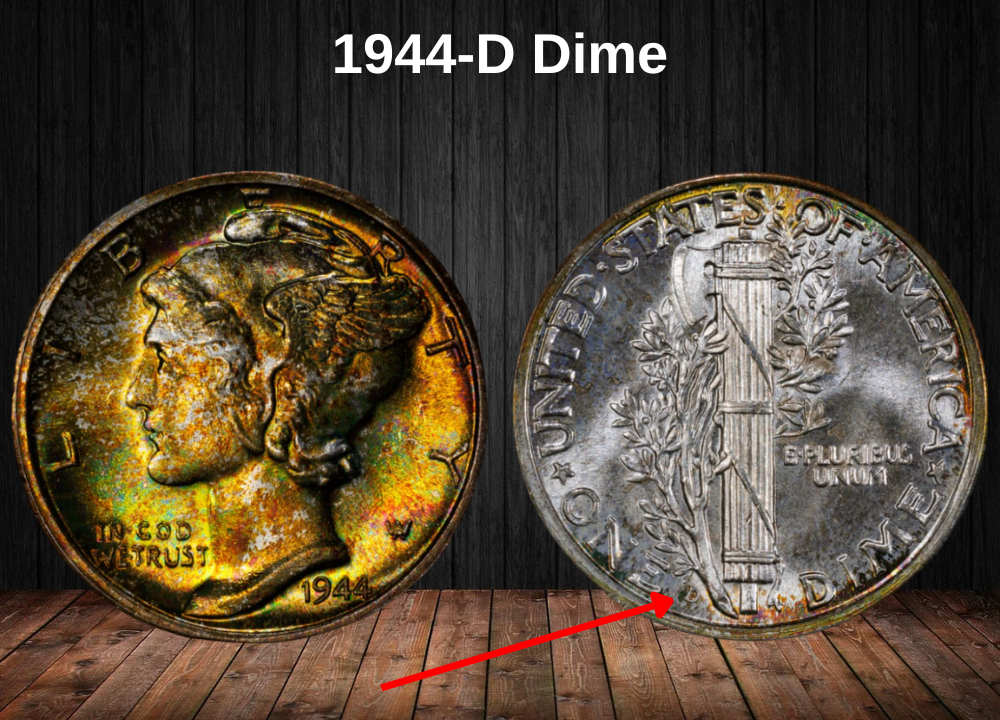
The Denver Mint produced 62,224,000 dimes in 1944. All carry the “D” mint mark. Generally, Denver coins are more affordable than Philadelphia strikes.
- In August 2022, an MS68 sold on eBay for just $720.
- A superior MS68+ FB brought $5,040 on April 28, 2019.
- In 2025, MS68+ FB coins are valued around $4,500.
Takeaway: Denver coins are plentiful, but top-end Full Bands examples still command strong collector interest.
1944-S Dime Value (San Francisco)
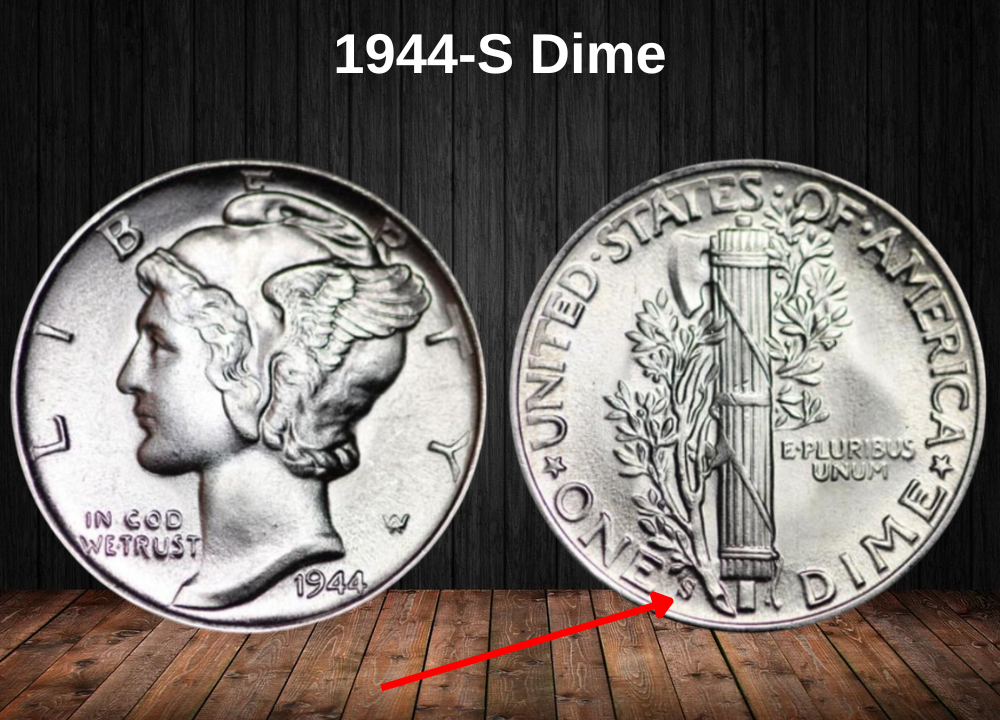
The San Francisco Mint struck 49,490,000 dimes in 1944, each with the “S” mint mark. Unlike other years, no proof coins were made between 1943 and 1945, due to wartime restrictions.
- An MS68 sold for $1,265 in 2006.
- A premium MS68 FB realized $11,750 on November 1, 2013.
- By 2025, experts estimate an MS68+ FB could fetch $20,000.
Takeaway: San Francisco dimes tend to be well-struck, making high-grade Full Bands survivors especially valuable.
Rare 1944 Mercury Dime Error List
Error coins are sometimes more valuable than flawless ones because they’re unique. These mistakes can occur during die creation, planchet preparation, or striking. Collectors pay premiums for dramatic errors, especially in higher grades. Here are the most notable 1944 Mercury Dime errors:
1944-D Dime DDO (Doubled Die Obverse) Error
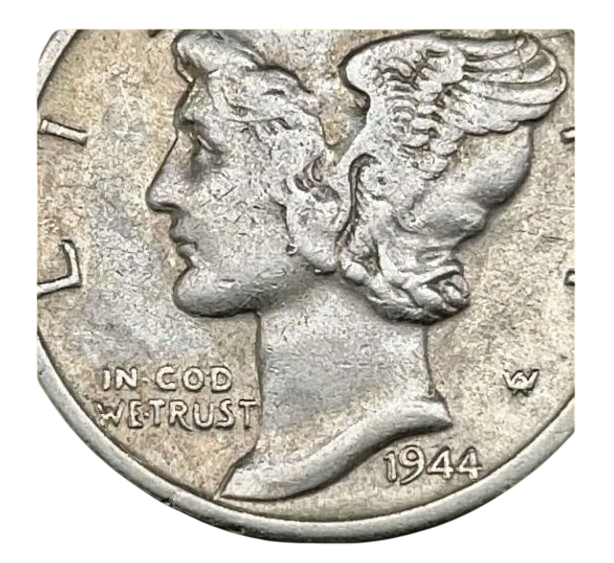
A DDO occurs when the die is struck more than once by the hub with a slight shift in alignment. This doubling transfers to every coin made with that die. Look closely at the date and lettering to spot this error.
- Value: $50 to $200 in Mint State.
1944 Dime Off-Center Error

Off-centers happen when a planchet isn’t seated properly in the press. The result is part of the design missing, with blank space showing on the coin. The more dramatic the shift, the more valuable.
- MS64 FB, 30% Off-Center: $1,100
- MS64 FB, 20% Off-Center: $515
1944 Double-Struck Flip-Over in Collar
This dramatic error occurs when a struck coin flips inside the collar and is struck again. On these, part of the reverse design overlaps the obverse. Collectors highly prize them for their eye appeal.
- MS62 Value: $3,400
1944 Broadstruck Error
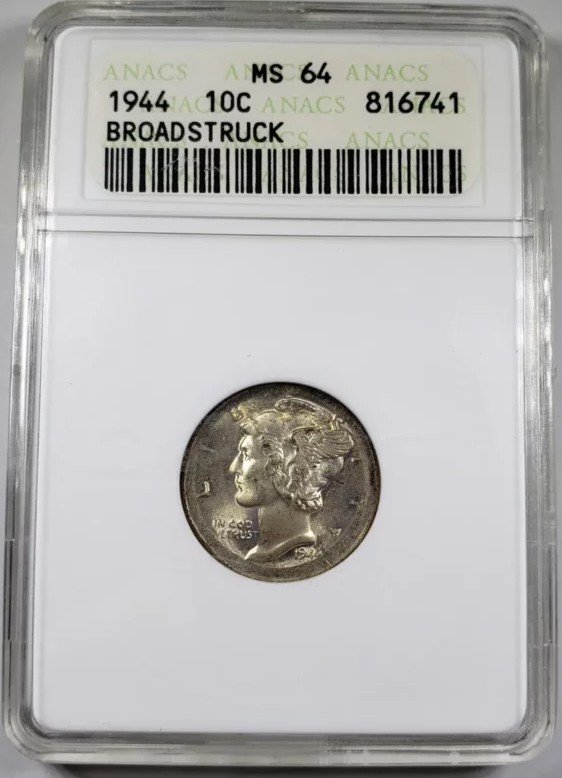
If the collar fails during striking, metal spreads outward, leaving a thicker rim and flatter edge. Broadstrikes are usually off-centered and slightly larger in diameter.
- MS63 FB: $115 to $335
1944-D Dime RPM (Re-Punched Mint Mark) Error
An RPM happens when the “D” mint mark was hand-punched more than once in different spots, leaving a shadow of the first impression.
- MS67: $255 (2014)
- MS67 FB: $995 (2021 eBay sale)
1944 Dime Obverse Struck-Thru Error
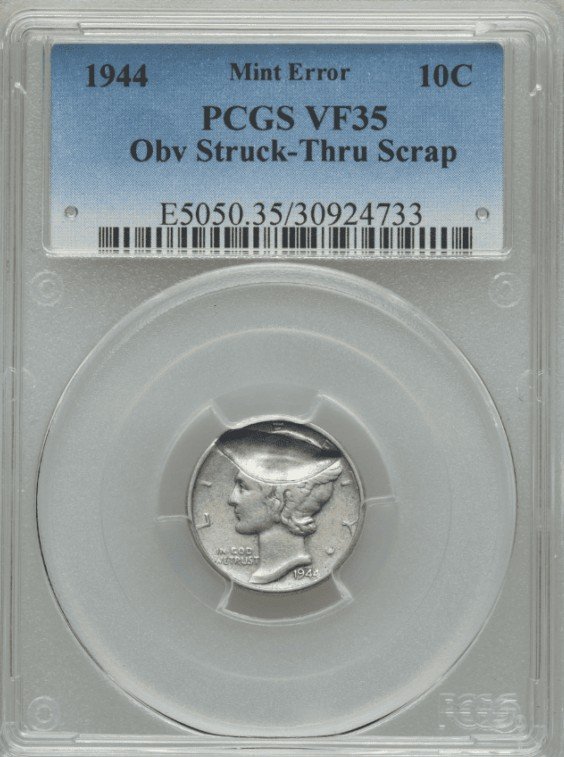
Foreign material, like a staple, cloth, or metal fragment, sometimes gets trapped between the die and planchet. It leaves a shadow or indentation on the coin. If the object remains embedded, the coin is worth even more.
- VF35 Example: $100
1944 Dime Clipped Planchet Error
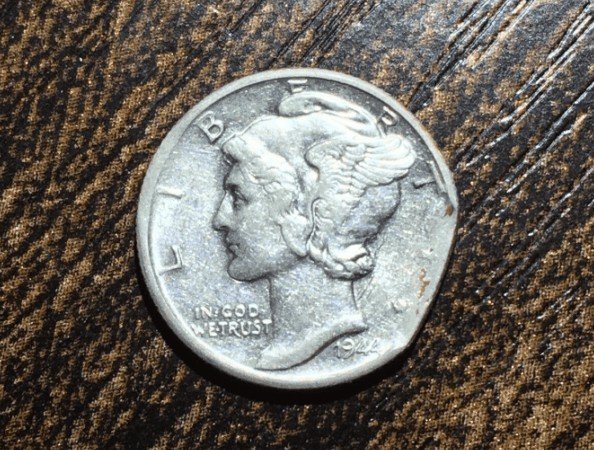
Planchets are cut from large metal sheets. Sometimes blanks are clipped near the edges, leaving a curved bite mark.
- AU55 with 12% Clip: $50
1944-S Dime Ragged Clip Error (10%)
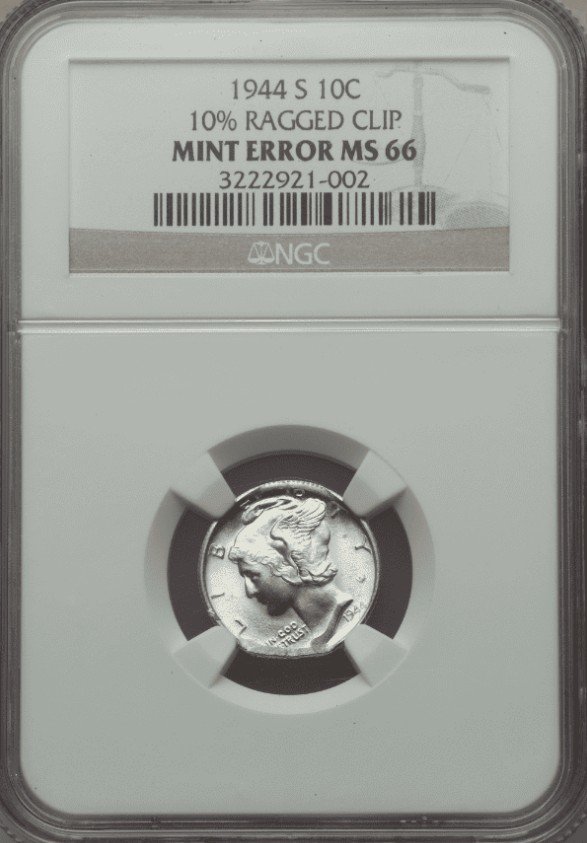
Instead of a clean curved clip, a ragged clip looks torn and uneven, often from the edge of the planchet sheet. Because this example was high-grade, it sold above expectations.
- MS66 Ragged Clip: $125
Where to Sell Your Dime Coin?
Now that you know the value of your dime, the next step is deciding where to sell it. There are several trusted options—both online and in person—that can help you get the best price depending on your coin’s rarity and condition.
To see the full list of recommended places, along with their advantages and disadvantages, check our complete guide on where to sell your dime coins.
FAQ about the 1944 Mercury Dime Value
1. What is the melt value of a 1944 Mercury Dime?
The coin is 90% silver and 10% copper, weighing 2.5 grams. Its melt value depends on silver prices, but generally ranges between $2 and $3.
2. How much is a 1944 Mercury Dime worth in circulated condition?
Most circulated 1944 dimes are worth between $3 and $10, depending on wear and mint mark.
3. Which 1944 Mercury Dime is the most valuable?
High-grade Full Bands (FB) examples are the most valuable. A 1944 Philadelphia MS68 FB once sold for $25,300.
4. Where is the mint mark on a 1944 Mercury Dime?
The mint mark (“D” for Denver or “S” for San Francisco) is on the reverse, to the left of the fasces, near the bottom of the olive branch. Coins from Philadelphia have no mint mark.
5. How rare is the 1944 Mercury Dime?
The 1944 dime had a high mintage—over 342 million across all mints—so it’s not rare in circulated grades. Scarcity and value come from high-grade coins with FB details or mint errors.
6. What does “FB” mean on Mercury Dimes?
“FB” stands for Full Bands, referring to the horizontal bands on the fasces on the reverse. If they are fully separated and well-struck, the coin earns a premium.
7. Are there any rare errors in the 1944 Mercury Dime?
Yes. Collectors seek out off-center strikes, doubled dies, clipped planchets, broadstrikes, and RPM (re-punched mint mark) errors. Some error coins can be worth hundreds or even thousands.
8. Why is the 1944 dime called a “Mercury Dime”?
The design shows Lady Liberty wearing a winged cap, but many mistook her for Mercury, the Roman god with winged helmet. The official name is the Winged Liberty Head Dime.


